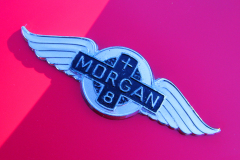Morgan | Mini
The Morgan Motor Company is a family-owned British car manufacturer founded in 1910 by Henry Frederick Stanley Morgan.
Morgan’s early cars were two-seat or four-seat three-wheelers, produced in two series. Morgan V-Twin (1911-1939) and Morgan F Series (1932-1952). A Morgan 3 Wheeler 2-seater roadster was revived in 2015.
Three-wheeled vehicles, by avoiding the British tax on cars, were classified as motorcycles and called cyclecars. Competition from small cars like the Austin 7 and the original Morris Minor, with comparable economy and price and better comfort, made cyclecars less attractive.
Morgan’s first four-wheeler, named the Morgan 4/4, because it had a four-cylinder engine and four wheels, was released to the public in 1936. Followed by a four-seat model in 1937, and a drophead in 1938.
The Morgan Plus 4 (+4) (1950-1969) was a more powerful and slightly longer version of the Morgan 4/4. The Morgan +4 was revived from (1985 -2000) and again from 2005.
The Morgan Plus 8 (+8) (1968-2004) was a Rover V8 powered, 2-seater roadster. The Morgan +8 was put back into production in revised form in 2012.
The Morgan Roadster (2005 – present) replaced the Morgan + 8. The car is identical to the Morgan +8, except it has a Ford V6 engine and is also available as a 4-seater.
The Morgan Aero 8 (2001-2009) is the first new Morgan design since the 1964’s Morgan +4+. It does not use anti-roll bars, and has an aluminum chassis and frame. Criticized for its “crosseyed” look, Morgan changed the design from 2007 onwards. A new Aero 8 was announced in 2016.
Morgan cars can be found in many areas of motorsport, from club and historic racing to more prominent examples such as the Le Mans 24hr race.
All Morgan’s are coach built, assembled by hand and have an ash or poplar sub-frame (except the Aero Series). Morgans have always had sporting or “sports car” performance, due to their extremely low weight.
Among their enthusiasts, Morgans are affectionately known as “Moggies”.
The original two-door Mini was a small car produced by the British Motor Corporation (BMC) and its successors from 1959 until 2000.
In 1957, the Suez Crisis had sent fuel prices soaring and Sir Leonard Lord of the Morris Company issued his top engineer, Alec Issigonis, a challenge – design and build a small, economical, fuel-efficient car capable of carrying four adults, “a car for everyone”.
The challenge was met by pushing the wheels all the way out to the corners and turning the engine sideways, thus providing more stability and more space on the inside. This space-saving front-wheel-drive layout (which allowed 80% of the area of the car’s floorpan to be used for passengers and luggage) influenced a generation of car-makers.
The Mini is considered an icon of the 1960s. In 1999 the Mini was voted the second most influential car of the 20th Century. The Mini in some ways is considered the British equivalent to its German contemporary, the Volkswagen Beetle.
The Mini Mark I had three major updates – the Mark II, the Clubman and the Mark III. Within these was a series of variations including an estate car, a pickup truck, a van and the Mini Moke—a jeep-like buggy.
The Mini Cooper and Cooper “S” were sportier versions that were successful as rally cars, winning the Monte Carlo Rally several times. Designed in 1961 by British racing legend John Cooper the cars had more powerful engines, bigger brakes and improved tuning.
Initially Minis were marketed under the Austin and Morris names (Austin Seven and Morris Mini-Minor) until Mini became a marque in its own right in 1969. The Mini was again marketed under the Austin name in the 1980s.
The last two door Mini Mark VII (a red Cooper Sport) was driven off the production line by the pop singer Lulu, and was subsequently housed at the Heritage Motor Centre, alongside the first Mini Mark I ever made.
The marque was rebranded MINI when BMW acquired it in 1994 as part of the Rover Group (formerly British Leyland).
In 1969, the original British Mini was featured in the gold-heist film “The Italian Job” starring Michael Caine and Noël Coward.. In 2003, the new Mini Cooper was shown in a remake of “The Italian Job” starring Mark Wahlberg and Charlize Theron.








